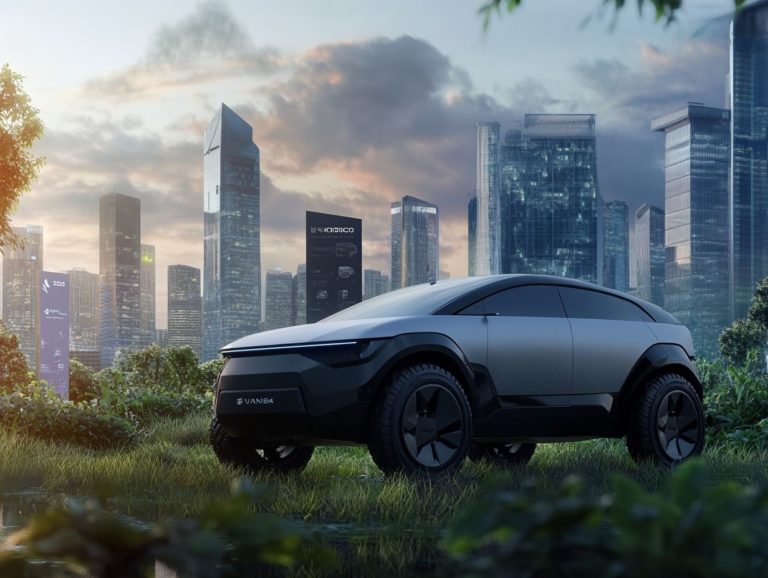electric vehicle adoption rates: global insights
Electric vehicles (EVs) are swiftly reshaping the automotive landscape, leading us into an era characterized by sustainable transportation.
Understanding adoption rates is essential. These figures reveal consumer preferences and highlight the broader economic and environmental trends that drive change.
This article explores the factors influencing EV adoption rates, highlights global trends and key regions, and examines the challenges and opportunities ahead.
It also offers future predictions and effective strategies to boost adoption, all crucial for paving the way to a greener future.
Contents
- Key Takeaways:
- Overview of Electric Vehicle Adoption Rates
- Factors Influencing Adoption Rates
- Global Trends in Electric Vehicle Adoption
- Future Predictions for Electric Vehicle Adoption
- Strategies for Increasing Adoption Rates
- Frequently Asked Questions
- What are electric vehicle adoption rates?
- Why are electric vehicle adoption rates important?
- What is the current global electric vehicle adoption rate?
- Which countries have the highest electric vehicle adoption rates?
- What are some factors influencing global electric vehicle adoption rates?
- How can we increase global electric vehicle adoption rates?
Key Takeaways:

Electric vehicle adoption rates are rising globally due to economic, environmental, and technological factors.
Countries like China, Europe, and the United States are leading the charge, but challenges remain.
The future looks bright for EVs, promising significant reductions in carbon emissions.
To boost adoption, effective strategies must be implemented by governments and industries.
Overview of Electric Vehicle Adoption Rates
Electric vehicle (EV) adoption rates serve as vital indicators of the automotive industry’s transition toward sustainable transportation solutions. For the latest updates, check out electric vehicle news: insights from industry leaders. This trend marks a noteworthy shift from internal combustion engines to cleaner battery-electric vehicles and plug-in hybrids.
This shift unfolds due to several factors, including government incentives, changing consumer preferences, and the urgent need to reduce carbon emissions to align with climate goals set by organizations like the International Energy Agency.
Regions such as Norway and China are frontrunners in electric car sales, significantly shaping global data on the growth of the EV market.
Definition and Importance
Electric vehicles (EVs) run fully or partially on electricity. They are a cleaner option compared to traditional vehicles, which mostly rely on fossil fuels.
The appeal of EVs is enhanced by their diversity. Battery-electric vehicles (BEVs) run solely on electric power, while plug-in hybrids (PHEVs) cleverly combine electric batteries with internal combustion engines for added flexibility.
As global concerns about climate change intensify, embracing EVs is vital for reducing greenhouse gas emissions. Studies suggest that switching to electric transportation could cut emissions by up to 70% by 2050.
Current market trends highlight this shift, with EV sales surging there was a remarkable 43% increase in 2020 alone. This signals a thrilling movement toward sustainable transport solutions that you won t want to miss!
Factors Influencing Adoption Rates
Several key factors significantly influence electric vehicle (EV) adoption rates. These include government incentives, the price of electric vehicles, and the future of buying electric vehicles, particularly regarding the availability of charging infrastructure.
Each of these elements plays a crucial role in shaping consumer preferences for cleaner transportation solutions.
Economic, Environmental, and Technological Factors
Economic, environmental, and technological factors play a pivotal role in shaping the landscape of electric vehicle (EV) adoption. As battery technology advances and awareness of environmental benefits grows, we see a significant shift towards reduced fossil fuel dependency and an expanded market share for electric vehicles.
These factors are intricately connected. Advances in battery technology reduce costs, making EVs more accessible than ever. Automakers are leveraging modern manufacturing practices and sourcing materials locally, which accelerates production and lowers overall expenses.
From an environmental standpoint, transitioning to electric vehicles can dramatically reduce greenhouse gas emissions, fostering cleaner air and promoting better public health outcomes. This shift creates jobs in green technology and boosts energy security by reducing reliance on imported fossil fuels.
This illustrates a promising trend toward a more sustainable future.
Global Trends in Electric Vehicle Adoption
Global trends in electric vehicle (EV) adoption show a major shift in what consumers want and how the market behaves, with insights on electric vehicle sales projections: 2024 and beyond being particularly revealing.
Norway and China lead the charge in EV sales, setting the standard for cleaner transportation solutions that cut down carbon emissions.
Leading Countries and Regions

Countries like Norway and China are showing impressive EV adoption. They benefit from strong government incentives, diverse EV options, and sales trends that support cleaner transportation.
In Norway, the government provides fantastic perks, including tax exemptions and dedicated parking for EVs. These incentives encourage many to switch.
Meanwhile, China is investing heavily in EV infrastructure. They are building a vast network of charging stations and offering subsidies to manufacturers and buyers alike.
Such support makes it practical and attractive to purchase electric vehicles. This growing availability reflects a global movement toward sustainable transportation.
Challenges and Opportunities
The EV market presents challenges and opportunities on the path to broader adoption. You might face issues like limited charging stations and high costs.
However, emerging technologies and growing public awareness create exciting possibilities for reducing emissions and promoting sustainability.
This evolving landscape highlights the industry’s dual nature. Breakthroughs in battery technology and new investments could revolutionize the sector, improving vehicle efficiency and lowering costs.
As environmental concerns grow, it s crucial to address these challenges. By overcoming current limitations, the EV market can significantly advance climate goals and foster a cleaner planet.
Future Predictions for Electric Vehicle Adoption
Future predictions indicate a remarkable growth trajectory for electric vehicle (EV) adoption. This surge is driven by rising battery demand and advancements in charging technologies, making it essential to keep an eye on electric vehicle trends to watch in the next decade.
As the industry evolves, you will find yourself at the forefront of this transformative shift in transportation.
Expected Growth and Impact
The anticipated growth in EV sales will significantly impact global carbon savings and market dynamics. Transitioning to battery-electric vehicles and plug-in hybrids plays a vital role in reducing your carbon footprint.
This shift not only changes the automotive industry’s competitive landscape but also aligns with international sustainability goals. Analysts predict that by 2030, EV sales could make up a major portion of total vehicle sales.
These advancements are crucial in the fight against greenhouse gas emissions. They may also encourage governments and businesses to invest more in renewable energy, creating a cycle of environmental responsibility.
Strategies for Increasing Adoption Rates
To boost electric vehicle (EV) adoption rates, consider a collaborative approach that includes government policies, industry initiatives, and expanding charging infrastructure.
This strategy will engage consumers and lower barriers, making it easier for everyone to switch to electric vehicles.
Government Policies and Industry Initiatives
Government policies and industry initiatives are crucial for driving electric vehicle (EV) adoption. These measures include consumer incentives and investments in public charging infrastructure that help reduce carbon emissions and promote cleaner transportation solutions.
These initiatives not only lower the upfront costs of purchasing an EV but also improve charging infrastructure, effectively addressing the fear of running out of battery power for potential buyers.
Case studies from countries like Norway and the Netherlands highlight how tax breaks and subsidies can significantly boost market penetration.
Partnerships between automakers and local governments have also led to extensive charging networks. This collaborative approach fosters an environment ripe for innovation, ensuring that both consumers and industries are prepared for a more sustainable future.
Frequently Asked Questions

What are electric vehicle adoption rates?
Electric vehicle adoption rates refer to the percentage of total vehicles on the road that are electric or hybrid. For insights on this topic, you can explore electric vehicle news: consumer satisfaction trends, which includes both fully electric and plug-in hybrid vehicles.
Why are electric vehicle adoption rates important?
These rates reflect the shift toward more sustainable and environmentally friendly transportation options. As the world faces climate change and air pollution challenges, exploring the global EV charging landscape is crucial for adopting electric vehicles, which helps reduce carbon emissions and improve air quality.
What is the current global electric vehicle adoption rate?
As of 2023, the global electric vehicle adoption rate is approximately 10%. This rate is expected to increase significantly in the coming years due to government incentives, technological advancements, and rising consumer demand for electric vehicles. For the latest updates, check out electric vehicle news: impact of global events.
Which countries have the highest electric vehicle adoption rates?
Currently, Norway leads the world with the highest electric vehicle adoption rate, where over 74% of new cars sold in recent years are electric or hybrid. For more insights on this trend, including shifts in consumer preferences, check out the latest electric vehicle news. Other countries with high adoption rates include Iceland, Sweden, the Netherlands, and China.
What are some factors influencing global electric vehicle adoption rates?
The adoption of electric vehicles is influenced by government policies, availability of charging infrastructure, cost and availability of electric vehicles, and consumer attitudes and preferences.
How can we increase global electric vehicle adoption rates?
Governments can implement policies and incentives to make electric vehicles more affordable, such as tax credits and investments in charging infrastructure. Consumers can also contribute by choosing to purchase electric vehicles and supporting companies promoting sustainable transportation options.






